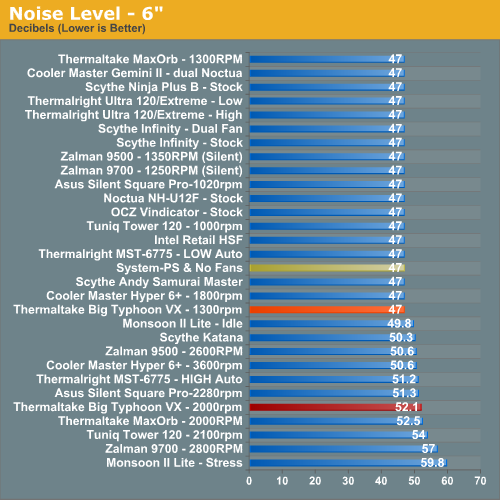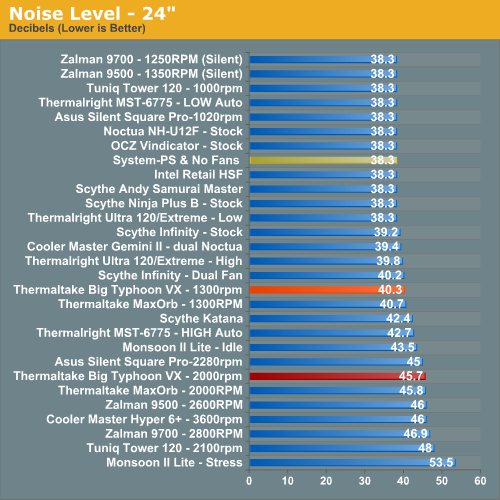Thermaltake Big Typhoon VX: Does VX Rule Cooling?
by Wesley Fink on June 7, 2007 5:10 AM EST- Posted in
- Cases/Cooling/PSUs
Noise
For many enthusiasts upgrading cooling the goal is maximum stable overclock, and they will live with the inconvenience of a louder system. For other users silence is the most important factor, and these users will forgo maximum overclocking if that increases system noise levels.
There are virtually no power supplies that do not include a fan. While Zalman and a few others do make an expensive fanless power supplies, we have not seen a fanless unit larger than 500W, or one that would be used for seriously overclocking a system. With that in mind the noise level of the system with all fans turned off except the power supply was measured. The power supply used for the cooling test bed was the OCZ PowerStream 520, which is one of the quieter of the high performance power supplies.
We have also measured the Corsair 620-watt and Mushkin 650-watt power supplies which are reported to be quieter than the OCZ. Both the Corsair and Mushkin are indeed quieter at idle or start up speed. However, as soon as load testing begins and the PSU fan speed kicks up the measured noise level is almost exactly the same as the OCZ PowerStream 520 watt power supply.
We are currently in the process of evaluating "quieter" power supplies for an update to our cooler test bed. We will make changes to that test bed as soon as we are confident in the noise measurements and test procedures with a variable speed quiet PSU. We plan to evaluate additional power supplies and configurations in our upcoming 120mm fan roundup, at which point we will complete the transition to a revised and lower noise cooler test bed.
The noise level of the power supply was 38.3 dB from 24" (61cm) and 47 dB from 6" (152mm). The measured noise level of the test room is 36.4 dB, which would be considered a relatively quiet room with a noise floor slightly below the OCZ PowerStream 520 PSU.
We measured noise levels with the Thermaltake Big Typhoon VX with its fan at Low and High speeds. Results were then compared to the other coolers/fans tested in this category. Measured noise levels in this chart should be considered worst case. Measurements were taken with an open side of a mid tower case 6" and 24" from the HSF. Real world would be a completely closed case resulting in a further reduction in noise.


The measured noise levels at 6" and 24" are all but identical to the results with the Thermaltake MaxOrb. The VX actually specifies a low 16dB-A to 24dB-A noise levels , but at both low and high speeds noise was above the 24" noise floor at 40.3dB-A at low speed and 45.7dB-A at high speed. The VX fan is definitely audible, but the noise is not particularly irritating in frequency. If you are very sensitive to noise you should be aware you will likely hear the VX fan, at least with an open case.
At the 6" measurement the Big Typhoon VX was below the noise floor at low speed, and significantly above the noise floor of 47dB-A at high speed with a measured 52.1dB-A. The Thermaltake MaxOrb, the Tuniq Tower 120 on high, the Zalman 9700 on high, and the Monsoon II Lite stressed were noisier than this, but this is still one of our highest measurements among the tested coolers. Again the noise frequencies are well placed and not particularly irritating as there is none of the high-pitched whine that some fans generate, but this is definitely not a silent or near-silent cooler if noise levels are your primary concern.
For many enthusiasts upgrading cooling the goal is maximum stable overclock, and they will live with the inconvenience of a louder system. For other users silence is the most important factor, and these users will forgo maximum overclocking if that increases system noise levels.
There are virtually no power supplies that do not include a fan. While Zalman and a few others do make an expensive fanless power supplies, we have not seen a fanless unit larger than 500W, or one that would be used for seriously overclocking a system. With that in mind the noise level of the system with all fans turned off except the power supply was measured. The power supply used for the cooling test bed was the OCZ PowerStream 520, which is one of the quieter of the high performance power supplies.
We have also measured the Corsair 620-watt and Mushkin 650-watt power supplies which are reported to be quieter than the OCZ. Both the Corsair and Mushkin are indeed quieter at idle or start up speed. However, as soon as load testing begins and the PSU fan speed kicks up the measured noise level is almost exactly the same as the OCZ PowerStream 520 watt power supply.
We are currently in the process of evaluating "quieter" power supplies for an update to our cooler test bed. We will make changes to that test bed as soon as we are confident in the noise measurements and test procedures with a variable speed quiet PSU. We plan to evaluate additional power supplies and configurations in our upcoming 120mm fan roundup, at which point we will complete the transition to a revised and lower noise cooler test bed.
The noise level of the power supply was 38.3 dB from 24" (61cm) and 47 dB from 6" (152mm). The measured noise level of the test room is 36.4 dB, which would be considered a relatively quiet room with a noise floor slightly below the OCZ PowerStream 520 PSU.
We measured noise levels with the Thermaltake Big Typhoon VX with its fan at Low and High speeds. Results were then compared to the other coolers/fans tested in this category. Measured noise levels in this chart should be considered worst case. Measurements were taken with an open side of a mid tower case 6" and 24" from the HSF. Real world would be a completely closed case resulting in a further reduction in noise.


The measured noise levels at 6" and 24" are all but identical to the results with the Thermaltake MaxOrb. The VX actually specifies a low 16dB-A to 24dB-A noise levels , but at both low and high speeds noise was above the 24" noise floor at 40.3dB-A at low speed and 45.7dB-A at high speed. The VX fan is definitely audible, but the noise is not particularly irritating in frequency. If you are very sensitive to noise you should be aware you will likely hear the VX fan, at least with an open case.
At the 6" measurement the Big Typhoon VX was below the noise floor at low speed, and significantly above the noise floor of 47dB-A at high speed with a measured 52.1dB-A. The Thermaltake MaxOrb, the Tuniq Tower 120 on high, the Zalman 9700 on high, and the Monsoon II Lite stressed were noisier than this, but this is still one of our highest measurements among the tested coolers. Again the noise frequencies are well placed and not particularly irritating as there is none of the high-pitched whine that some fans generate, but this is definitely not a silent or near-silent cooler if noise levels are your primary concern.










34 Comments
View All Comments
Xajel - Thursday, June 7, 2007 - link
AnandTech never reviewed the BT VX before, and when it did, it had concluded that this cooler is bad, why just coz another type of coolers are better !!the problem with this review is that the Cooler is very good, but the conclution did not give it what it deserve. it just said that a 90 degree mounted fans coolers are better.. ok I agree and thanks for AT for this, infact I just knows that thanks to Anand, but the problem is where the conclution for the VX as a cooler not as heatpipes tower vs. downfacing fans coolers comparision..
Wesley Fink - Thursday, June 7, 2007 - link
We did NOT say the BT was a bad cooler. We talked about the performance being the best for this type of cooler and the good things about installation and design. Don't you think It would be unfair to say the VX topped our perfromance list when it didn't?In our conclusion we also said "There is no doubt the Big Typhoon VX is, along with the Cooler Master GeminII, the best of the down-facing cooler designs." and "While performance does not top our charts, there are still many things to like about the Thermaltake Big Typhoon VX. It is one of the easiest to mount coolers we have ever tested. While we do have concerns about two pounds being supported by Intel-style push clips, the installation itself is easy and does not require you to remove your motherboard. It is equally easy if you are mounting the VX on an AMD processor.
The attached fan speed control is also very useful on the Big Typhoon VX, particularly since it is attached to a very high-output fan capable of 86.5CFM at high speed."
I don't think this is saying the cooler is bad.
DrMrLordX - Thursday, June 7, 2007 - link
It isn't a bad cooler at all. However, there are some ways to make it perform well under its potential.First off, it needs a side air duct or side case fan blowing down onto it so it can breathe efficiently. Give it that, and it will be far less likely to cycle hot air through its fins at high operating temperatures.
Secondly, it does need a fairly strong exhaust fan.
The Big Typhoon (standard and VX) has put in impressive showings on open-air testbeds that showcase its potential strengths. In restricted air environments, you wind up with a cooler that can not efficiently pull cool air into the case or move hot air out of the case (the latter of which is a nice feature of a properly-positioned L-shaped cooler).
I managed to get good operation out of mine using a Centurion 5. All I did was pull the side air duct off (the VX is too big to be mounted with that thing still screwed on to the side of the case) and use the VX's included fan as an exhaust. Then I put a Silverstone FM-121 on the VX itself. It serves as the intake fan for the case, cooling everything but the HDDs, plus the HSF fan as well. The exhaust fan more or less takes care of everything else. It's a simple and cheap solution that cools very well. In contrast, an L-shaped cooler in a similar setup would have problems due to there being no strong or direct intake . . . it would essentially be pulling air from inside the case which would, ideally, pull cool air from outside the case through various vents, but for the most part, it would also be pulling in air heated by other system components.
All this might account for why the VX did so well at idle but so poorly at load.
strikeback03 - Friday, June 8, 2007 - link
My Tuniq on an E6600 in a Centurion 5 idles at 27-28*C and goes to 33-34 at load with ambient around 75*F and just the stock case fans (80mm at front blowing in over hard drives, 120mm at back blowing out). The Tuniq is set to ~1350RPM.